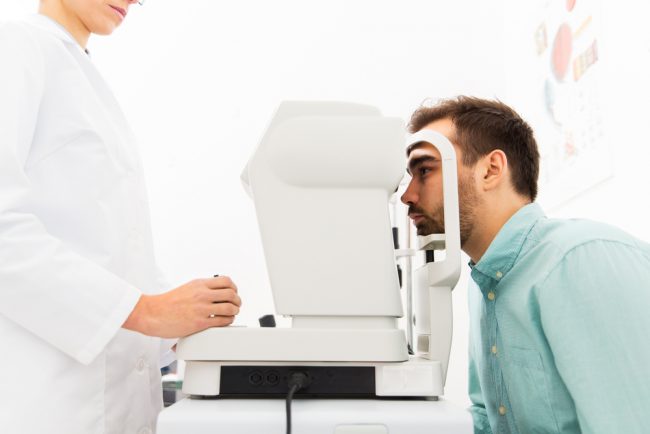
Neurological eye screenings conducted at our Optical Masters’ office provide you and your medical provider with important information about the state of your vision. Evaluating how your eyes and pupils work together and separately can tell your medical provider if the nerves and muscles controlling your eyes are functioning properly or suffering from a dangerous condition or disease. Damage to the central nervous system can affect your vision, which will greatly impact your daily activities. Your vision is one of your greatest physical senses, and as such, it should be protected by ensuring the neuromuscular structures are strong and working properly. We provide high-quality and cost-effective care to each and every one of our patients. Call us today for your eye screening and to see how healthy your eyes are.
How the Eyes Work
Light hits our eyes in the form of light waves, where the information is then sent to our brain and processes what we see. When you look at an object, light rays reflect off of that object and enter your eye through the cornea, or the clear layer of the eye that covers the iris and pupil. Depending on what light rays are absorbed and what light rays are reflected, your brain will be able to know the color of the objects around you. The cornea bends the light rays that pass through your pupil or the black circle in your eye that acts similar to the aperture lens on a camera. Your iris can widen or narrow depending on the amount of light that hits it, which in turn narrows or widens the pupil, regulating the amount of light that passes through and is processed. The pupil will enlarge (widen) in the dark and become small and narrow when there is a lot of bright light. The retina is a thin layer of tissue at the back of your eye that interprets the light rays that pass through the pupil with light-sensing nerve cells called rods and cones. These nerve cells send electrical impulses to the brain that tells the brain what you are looking at. The optic nerve is located at the back of the eye, connecting to the brain to transmit visual information.
Neurological Eye Screenings
Did you know that there are over 100 ways to test the eyes during a neurological eye screening? The eyes are so complex and important and many small parts need to be checked for visual acuity and accuracy. We won’t do all 100 eye screening tests on your eyes but will cater to our appointments to your specific needs, symptoms, and concerns. The American Optometric Association gives general guidelines for the frequency of children and adults to visit their optometrist. Babies should be checked at 6 months of age for eye abnormalities. Children 2 to 5 years of age should be checked by age 3 and as needed afterward if they are at risk for visual problems. Those 6 to 18 years old should have their eyes checked every two years, whereas those who are at risk or already have visual problems should have an eye screening every year. The same recommendation is given for those between 18 and 60 years of age. A good rule of thumb is to come to see us every year for your eye screening, as the eyes and vision can change during that time period even if the change is very subtle.
A neurological eye screening is meant to detect changes in the eyes or impairments that could lead to vision loss or eye diseases. During your appointment, you will sit in a chair and we will use a device called a Phoropter that you will look into (kind of looking into binoculars) so that we can see inside and outside your eye. You will look at a succession of test charts through various lenses placed in the Phoropter to determine what type of vision you have. We will also use a light to inspect the eyes and any irregularities we see in the shape or structure of parts such as the cornea, pupil, retina, optical nerve, etc. We can actually see inside of your eye and the structure to determine if everything is working properly. For some patients (such as children), we might do cover testing (covering one eye), photo screening, corneal light reflex testing, visual acuity testing with eye charts, and more depending on age and the needs of the patient. We like to always test your eye muscles to see if both eyes are working together properly, as this is essential to vision. If your symptoms (or lack of symptoms) seem to be similar from year to year, you will get into a routine of how your eye screening will go.
Why Eye Screenings Are So Important
Eye screenings are done to detect any irregularity that could cause vision loss. Common problems we search for are eye misalignments, nearsightedness, farsightedness, cataracts, glaucoma, drooping eyelids, astigmatism, symptoms of any neurological disease, etc. Any number of these conditions will affect your eyesight and how you interpret the world around you. With severe eye problems, your life could be disrupted so much that you cannot work or do things on your own. The good news, however, is that many eye conditions can be treated early on and some even reversed. That’s why it’s so important to have your eye screenings annually or biannually if you are at risk so that we can find problems and eliminate them. At Optical Masters, we know that your eyes are one of your most important senses, and we will do all that we can to protect and treat them so you have an amazing vision for life. If you’re due for an eye exam or have been experiencing abnormal symptoms or vision problems, call us today at (720) 780-8881 for your neurological eye screening.










 {{menu-footer}}
{{menu-footer}}